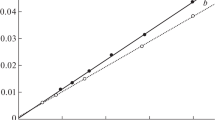Summary
TLC and HPTLC as chromatographic separation procedures differ in data processing: TLC is a discontinuous process in the local domaine using off-line data processing while HPLC as a continuous process in times domaine needs on-line data processing. In HPLC fully automated (in the sense of fully mechanized) systems are state of the art, in TLC only spotting and evaluation are fields of interest in automatization. As there is a need of real positioning in the x/y-coordinates a computer controlled way has advantages compared to automated scanning equipments. In order to have low limits of determination a signal-to-noise enhancement may be used, but there are different ways in TLC or HPLC. The determination of non-separated peaks may be done in both methods by the same procedures as derivative or double wavelength techniques. In HPLC, using photodiodearray detectors, there are further possibilities as derivative spectroscopy or convoluting techniques by orthogonal polynominals in the spectral domaine. Calibration in TLC is restricted by the non-linear relationship between reflectance and mass of substance per spot. Non-linear regression techniques for instance using the Michaelis-Menten function are more reliable than the often used linearization methods.
Zusammenfassung
Obwohl die DC und HPLC Trennverfahren aus dem Bereich der Flüssigkeits-Chromatographie sind, unterscheiden sie sich in der Datenverarbeitung:die DC ist ein diskontinuierliches Analysenverfahren in der Ortsdomäne mit Off-line-EDV, die HPLC dagegen ein kontinuierliches in der Zeitdomäne mit zwingender On-line-EDV. Bei der HPLC ist die Vollmechanisierung Stand der Technik, bei der DC lassen sich sinnvoll nur die Auftragetechnik und die Auswertung automatisieren, wobei wegen der Positionierung der x/y-Koordinaten eine echte Rechnersteuerung sinnvoller ist als lediglich eine Scan-Automatik. Im Hinblick auf günstigere Bestimmungsgrenzen müssen bei beiden Verfahren unterschiedliche Methoden der Verbesserung des Signal/Rausch-Verhältnisses eingesetzt werden. Bei der Bestimmung nichtgetrennter Peaks dagegen können bei beiden Methoden dieselben Techniken (Ableitung, Mehrwellenlängenmessung) eingesetzt werden. In der HPLC ergeben sich darüber hinaus bei Verwendung von Photodiodenarray-Detektoren zusätzliche Möglichkeiten in der spektralen Domäne (Ableitungsspektroskopie, Anwendung von Orthogonalpolynomen). In der Kalibrierung gelten wegen des nichtlinearen Zusammenhangs in der DC andere Voraussetzungen, doch steht mit der nichtlinearen Regression über die Michaelis-Menten-Funktion eine vielseitig anwendbare Auswertung zur Verfügung.
Similar content being viewed by others
Literatur
Alert D, Ebel S, Geitz E, Schaefer U (1984) J Pharm Biomed Anal (im Druck)
Bertsch W et al. (1980) Instrumentalized HPTLC. Hüthig, Heidelberg
Draper NR, Smith H (1981) Applied regression analysis. Wiley, New York
Ebel S (1983) unveröffentlichte Auswertungen
Ebel S (1983) Comput Anwend Laborat 1:72–77
Ebel S, Alert D, Schaefer U (1984) Chromatographia 18:23–27
Ebel S, Geitz E, Hocke J (1980) siehe [2]: 55–80
Ebel S, Geitz E, Hocke J (1980) GIT Fachz Lab 24:660–665
Ebel S, Geitz E, Hocke J, Kaal M (1982) Kontakte (Merck) 1982 (1):39–44
Ebel S, Herold G (1975) Chromatographia 9:41
Ebel S, Herold G, Hocke J (1975) Chromatographia 8:573–576
Ebel S, Hocke J (1976) Chromatographia 9:78–81
Ebel S, Hocke J (1976) J Chromatogr 126:449–456
Ebel S, Hocke J (1977) Chromatographia 10:123–128
Ebel S, Kußmaul H (1974) Chromatographia 7:197
Ebel S, Kußmaul H (1974) Fresenius Z Anal Chem 269:10
Ebel S, Walter V (1983) unveröffentlichte Ergebnisse
Ebel S, Werner-Busse A (1983) Veröffentlichung in Vorbereitung
Ebel S, Werner-Busse A (1984) Fresenius Z Anal Chem 318:234–235
Frodyma MM, Frei RW, Williams DJ (1964) J Chromatogr 13:61
Geitz E (1981) Dissertation Marburg
George SA, Maute A (1982) Chromatographia 15:419–425
Glajch HL, Kirkland JJ (1983) Anal Chem 55:319A-336A
Hulpke H, Stegh R (1980) siehe [2]: 113–131
Jänchen D (1982) GIT Fachz Lab 26:Suppl Chrom 65–67
Kaiser H (1975) Fresenius Z Anal Chem 209:1–18
Kaiser RE (1982) Instrumental High Performance Thin-Layer Chromatography; Inst f Chromatographie, Bad Dürkheim
Kaiser RE (1980) s. [2]: 165–184
Kaiser RE, Rieder RI, Miller A, Pilgram B (1982) s. [27]: 335–350
Kaiser RE, Rieder RI, Miller A, Pilgram B (1983) Comput Applic Laborat 1:118–128
Klaus R (1964) J Chromatog 16:311
Kortüm G (1969) Reflexionsspektroskopie. Springer, Berlin Heidelberg New York
Kubelka P, Munk F (1934) Z Techn Phys 12:593
Kufner G, Schlegel H (1979) J Chromatogr 169:141
Ludwig R (1969) Fehler- und Ausgleichsrechnung. Vieweg, Braunschweig
Nill G (1983) Vortrag im Rahmen der Symposien „Fortschritte der Analysentechnik“; Hewlett-Packard
Noack S (1980) Statistische Auswertung von Meß- und Versuchsdaten mit Taschenrechnern und Tischcomputern. de Gruyter, Berlin
Otteneder H, Hezel W (1975) J Chromatogr 109:181
Pohl U, Schweden W, Lessing W, Metz G (1977) Fresenius Z Anal Chem 285:111
Schmutz HR (1980) siehe [2]: 315–343
Sistovaris N (1983) GIT Fachz Lab 27: Suppl. Chromatogr 17
Tausch W (1970) Meßtechnik 80:38
Wahbi AM, Ebel S, Steffens U (1975) Fresenius Z Anal Chem 273:183–187
Walter V (1983) Dissertation Marburg
Author information
Authors and Affiliations
Rights and permissions
About this article
Cite this article
Ebel, S. Datenverarbeitung in TLC/HPTLC und HPLC. Z. Anal. Chem. 318, 201–205 (1984). https://doi.org/10.1007/BF00528582
Received:
Issue Date:
DOI: https://doi.org/10.1007/BF00528582




